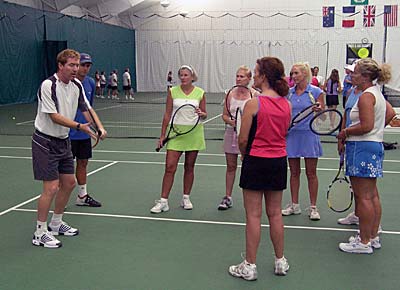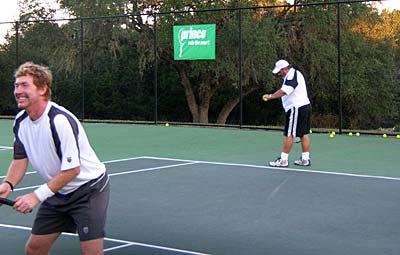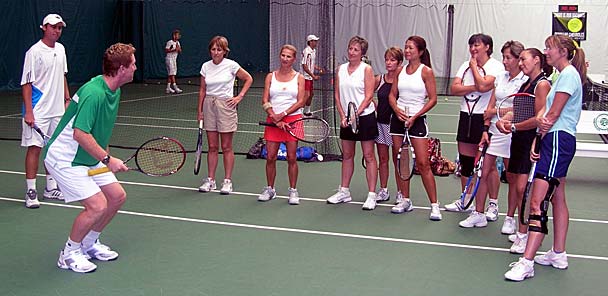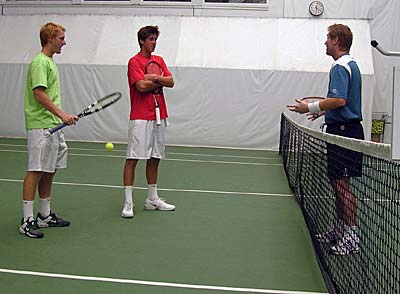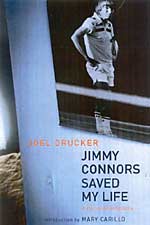|
TennisOne Lessons The Aussie Doubles Approach Joel Drucker Photos by Ken Munson The Australian Open is just around the corner, and while certainly there are tons of interesting storylines in the world of singles this year, as a recreational and highly-competitive player, one topic has always interested me: What is it that makes so many players from this nation so good at doubles? Going back more than 100 years, to the days of lefthander Norman Brookes (the first Aussie to win Wimbledon), on through to the likes of Frank Sedgman and Ken McGregor, Neale Fraser and Ashley Cooper, Fred Stolle and Bob Hewitt (yes, the South African is a native Aussie), Roy Emerson and anybody, John Newcombe and Tony Roche and, most recently, Mark Woodforde and Todd Woodbridge (aka “The Woodies”), as well as such great women doubles players as Margaret Court, Evonne Goolaong and in today’s game, Rennae Stubbs and Samantha Stosur, there’s no question residents of this one-time penal colony pair up exceptionally well.
Maybe that penal colony background is the key. Australia is a nation where the team stands much taller than any individual. One national premise: the tally poppy syndrome, wherein anyone dare put on too many airs and he will summarily be chopped down. While in such areas as business and the arts this can be quite destructive, in the realm of tennis it creates a great counterbalance for the sport’s over-the-top egotism. After all, most people commence their tennis lives playing singles and subsequently acquire their doubles insights more on-the-go than in any coherent manner. For the last 15 years I’ve attended an incredible annual fantasy camp, “Tennis Fantasies with John Newcombe and the Legends,” held at Newcombe’s ranch in New Braunfels, Texas. With Aussies such as Newcombe, Emerson, Stolle, Roche, Owen Davidson, Ross Case and Mark Woodforde, as well as Americans Charlie Pasarell, Dick Stockton, Marty Riessen and Rick Leach watching us civilians play matches against one another every day, it’s been a first-hand immersion in a world-class approach to team play. This year, Woodforde and Woodbridge have been nominated for induction into the International Tennis Hall of Fame. Having played in an era of increased power and physicality, it’s fascinating to hear his thoughts on doubles and how he and Woodbridge proved a classic principle that a great doubles team is a case of one plus one equaling three. As a lefthander myself who’s always had an easier time taking pace off the ball than generating it, I was particularly interested in Woodforde’s approach.
On a crisp October morning on Court Five of the ranch, Woodforde starts off with a simple idea – but one I know as a recreational player I’ve overlooked too often. Says Woodforde, “You’ve got to respect your partner as a player. You’ve also got to be honest with yourselves about what you can do – and what you can’t. Todd and I weren’t necessarily the hardest hitters, but we knew where we strong. We could volley well, we could return consistently, we could move. Only if you start with what you really know can you then begin to work on things that can make you better.” Seeing me play, for example, Woodforde (and all his other mates for that matter) could tell that I had reasonable reflexes, but also a tendency to rely too much on my hands than my entire body. “Get the feet and your knees involved,” he said. But beyond my own travails, Woodforde constantly stresses two aspects of doubles. The first premise is that in large part doubles is template-driven. In other words, the presence of more players actually reduces the number of variables. Watching us campers play, Woodforde and his mates issue a wide range of suggestions that may seem obvious; but if so, why are they neglected? Consider:
This last point was one of the Woodies’ greatest strengths – the ability to force opponents to hit yet one more shot in just about all circumstances. Once in the middle of a match, for example, Woodforde watched me try to angle a high backhand volley for a winner. “Who do you think you are, Tony Roche?” he asked, referring to the man with the greatest backhand volley in tennis history. The right play for the rest of us, Woodforde explained is to not get concerned about hitting the ball too hard and instead aim it deep and down the middle. “Make the other team come up with something special,” he said.
Years could be devoted simply to mastering these simple but easily-forgettable ideas. But then there’s a companion layer, one more subtle – and one that requires even more work. Watching me and a partner play one day, Woodforde said, “Quit standing around. Just because you’re not hitting the ball doesn’t mean you shouldn’t be moving your feet. Stay active, look to move forward, to take advantage of your partner’s return, to make adjustments when the ball comes your way, to throw the other guys off-balance.” He is so right. Check out your club on a Sunday morning and you’ll see a lot of statues. What about a fake poach? Or keeping the feet moving after hitting a return? So naturally, the day after hearing Woodforde’s advice, I made a go at all of these plays – and found myself far more tired both physically and mentally.
As you might expect at an event filled with 3.5-5.0 players, the role of the lob and the overhead become massively significant. A week of competition at Tennis Fantasies has often been turned around by one team’s ability to throw the ball up – and the other team’s inability to effectively put away high volleys and overheads. This is where the Aussies’ maniacal work ethic surfaces. Says Woodforde, “Go out there with your partner and spend time working on the shots you know you’re going to face. Don’t just hit returns and serves and whack your forehand. One guy can stand in the corner and toss up some lobs for ten minutes. Then switch it. Do this a lot and in time your overheads will improve.” And yet, beyond all the tactical and technical aspects of doubles, there's another concept the Aussies deeply understand. Says Stolle, "doubles is all about playing for your partner." I know that for a long time when playing doubles I was at heart a greedy singles player merely looking for a little more exercise and the chance to strike a few more big shots. But the Aussie approach is much different – and truly gets to the core of doubles. Emerson, for example, believes that recreational players go from not poaching at all to going poach-happy. "When your partner is serving on a big point, don't try to be a hero and think you can hit a lunging volley for a winner," says the man who won 16 Grand Slam doubles titles. "Have faith in your partner's ability to hit a good first volley and that your team can establish the right court position. Sure, it's one thing to poach at 40-love, and the fake poach is always helpful, but over the long term, when you poach like that you're not giving your partner and your team the right kind of confidence." Staying positive, building confidence for both players, making sensible decisions – these are the cornerstones of the Aussie philosophy. Thanks to the likes of Woodforde, Stolle and all their mates – as well as more than a few pointers from the folks I play with – I more and more have come to see how to be a viable doubles partner. Your comments are welcome. Let us know what you think about Joel Drucker's article by emailing us here at TennisOne.
Jimmy Connors Saved My Life: A Personal Biography Longstanding TennisOne writer Joel Drucker has just published his first book, Jimmy Connors Saved My Life: A Personal Biography. Mr. Drucker provides the most thorough examination ever attempted of one of the most complex characters in recent sports history. The book is both a comprehensive biography of the controversial tennis star and a look at how the author's life intersected and conflicted with Jimbo's. The book includes extensive analysis of Connors' tennis, including the vital impact his mother had as his primary coach, as well as the significant work the great Pancho Segura did in his formative years. Also covered are a great many of Connors' most important matches, as well as many personal interactions Drucker had with Connors that reveal unusual sides to him. Joel Drucker will be working for Tennis Channel at this year’s Australian Open. |
